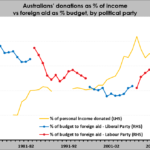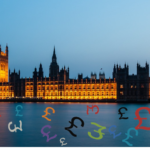Australian philanthropy improving, yet miles behind

Australians are donating more money than ever. Based on ATO data, tax deductible donations have increased from as $58 million in 1979 to a $2.6 billion in 2014[1]. This equates to an almost 4-fold increase in donations as a percentage of income. That been said, donations still amount to a tiny percentage of income. On average, Australians only donate 0.34% of their income. That’s 34 cents for every $100 earned. Also, while the percentage contributed increased steadily from 0.1% in the late 1970s, it seems to have plateaued over the last decade.

These figures make Australia look like the scrooge of the Anglo-world. America’s philanthropic culture sees them donating 10 times as much as Australians do as a percentage of their income. The UK donates 8 times more, Canada 2.5 times, and NZ donates 50% more[2].

(I compared Anglo countries as it was easier to find data online, and also due to the strong cultural aspects of philanthropy.)
According to analysis by the Fondation de France[3], British donors are the most generous in Europe. But based on their measures of comparable concepts, other wealthy Europeans donate around half what the Brits do, which makes it around 4 times what Australians donate. “Philanthropy in Europe” also suggests that countries with high taxes have lower individual contributions. High taxes suggest the government is looking after the needy, and thus individuals don’t have to. It further highlights countries where tax revenue amounts to over 40% of GDP (such as France, Belgium and Italy) having lower donor participation. Yet, Australia’s tax burden is around 25% of GDP[4] and Australians donations are so miserly they round down to 0%.
No matter how many kilometres people run, bike or walk, nor how white, black or pink their ribbons are – Australians donate less than a deconstructed latte a week in $ terms.
Let’s hope they at least donate to the right causes.
Who are the givers?
While donations came from across the community, the super-rich gave the lion’s share. Those with a taxable income over $1m (the top 0.1% of earners) gave 13% of all donations[5]. Those over $250k (the top 1.3%) gave 26% of all donations, and overall, half of all donations came from the top 15% of earners, those with a taxable income over $90k.

On the other hand, while the lowest earners (under $6,000) donated small amounts, they gave by far the most as a percentage of their income, donating almost 5% of their income. This seems to be somewhat driven by retirees who may have low incomes but potentially amounted large wealth.
The middle and upper middle classes ($40k to $150k) contributed the least as a percentage of their income (0.25%).
__________________________________________
Reply to 1st comment:

Sources:
[1] Table 1: https://www.ato.gov.au/About-ATO/Research-and-statistics/In-detail/Tax-statistics/Taxation-statistics-2013-14/?page=4#Individuals_detailed_tables
[2] USA: Table 2.1https://www.irs.gov/uac/soi-tax-stats-individual-statistical-tables-by-size-of-adjusted-gross-income
UK: Table 2.6 – https://www.gov.uk/government/collections/charitable-donations-and-tax-reliefs-statistics
Canada: http://www.cra-arc.gc.ca/gncy/stts/t1fnl-eng.html
New Zealand: http://www.ird.govt.nz/aboutir/external-stats/revenue-refunds/donation-rebates/
[3]https://www.fondationdefrance.org/sites/default/files/atoms/files/philanthropy_in_europe_2015_0.pdf (section D)
[4]https://en.wikipedia.org/wiki/List_of_countries_by_tax_revenue_as_percentage_of_GDP
[5] Table 3: https://www.ato.gov.au/About-ATO/Research-and-statistics/In-detail/Tax-statistics/Taxation-statistics-2013-14/?page=4#Individuals_detailed_tables

















hey, is this percentage of pre- or post-tax income?
Thanks for the question!
The percentages here from the “taxable income”; that is pre-tax, but post tax deductions. So, if I earn $80k, and deduct $2k in working from home, car allowance, and charities, then it’s the percentage of $78k.
Having said that, if we used the Post tax, it would not be much difference. I added a graph at the bottom of the post to show them both.